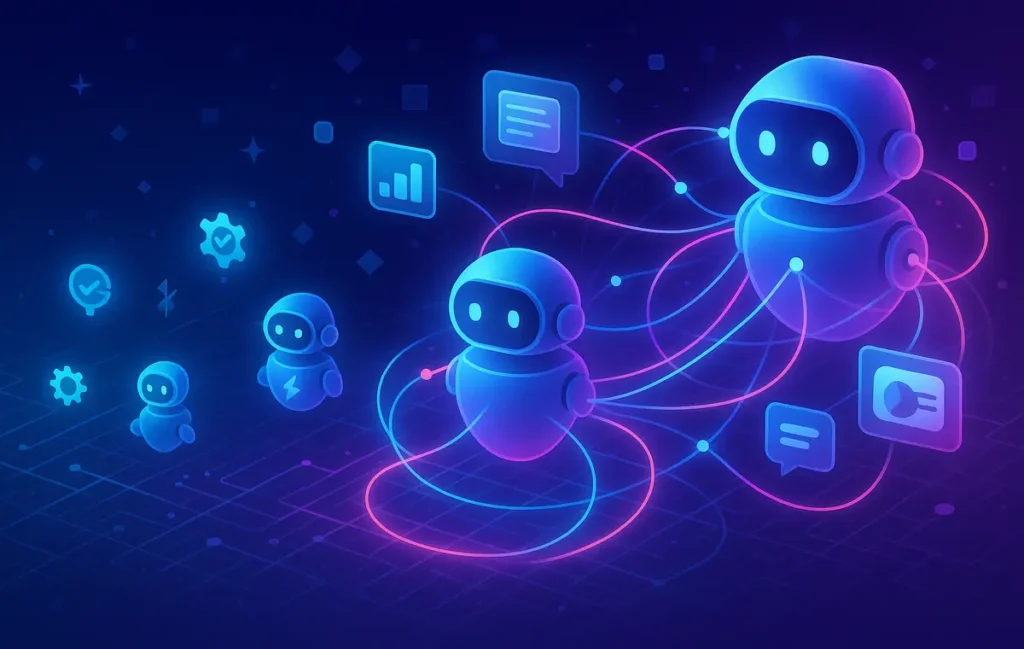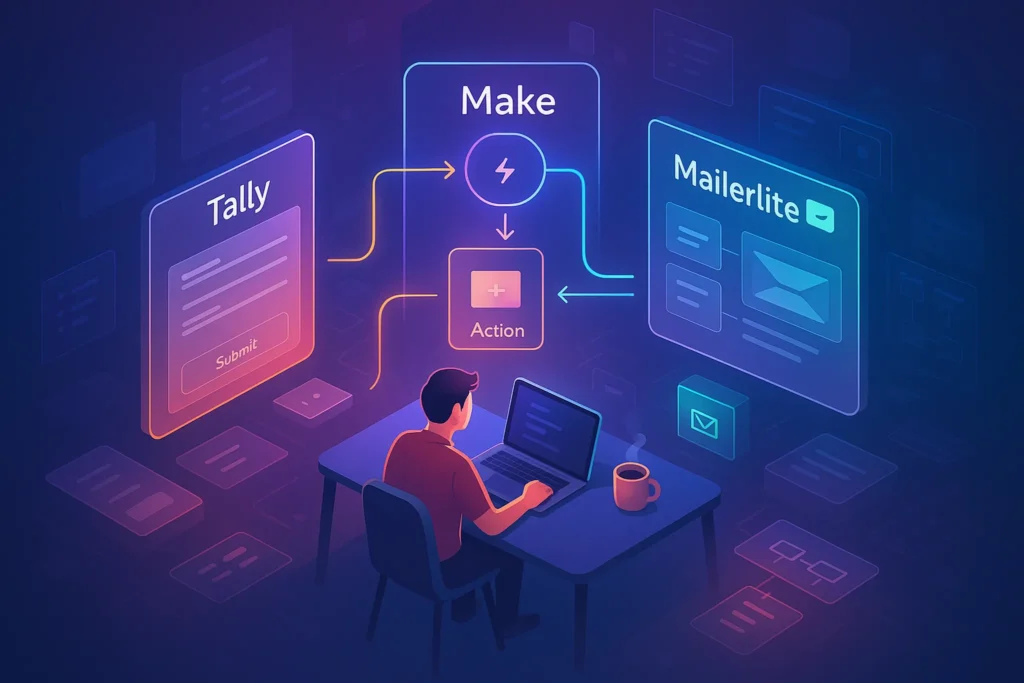🔥 Introduction: Why Everyone Is Talking About AI Agents
Not long ago, automation meant simple “if-this-then-that” rules—schedule a post, send an email, log a lead. But in 2025, the conversation has shifted to AI agents: tools capable of reasoning, learning, and running complex workflows without constant human supervision.
What sets AI agents apart is autonomy. They don’t just follow rigid triggers—they interpret context, remember goals, and adapt over time. That’s why founders, teams, and developers are asking the same question: Are AI agents the next revolution in work automation?
💡 Nerd Tip: If Zapier made automation mainstream, AI agents are making autonomy mainstream.
📘 What Are AI Agents?
At their core, AI agents are systems designed to perceive context, make decisions, and take actions—often across multiple tools. The simplest agents are task bots, like the kind you build with workflow automation 101 platforms such as Zapier or IFTTT. These bots follow rigid instructions: when A happens, do B.
Autonomous AI agents go further. They use reasoning models, memory, and multi-step planning to achieve goals. Instead of waiting for a single trigger, they can plan a series of actions, adjust midway, and even delegate tasks to other agents. This is the evolution from rule-based task bots to AutoGPT-style workflows.
Think of it this way: a task bot is like a calculator—it solves one problem quickly. An AI agent is like an assistant—it interprets your request, breaks it down, and manages the moving parts.
⚙️ Core Features of AI Agents
Modern AI agents share four key traits:
-
Context Awareness – They don’t just process instructions; they understand the environment. For example, a marketing agent can adjust messaging if it recognizes that engagement is dropping.
-
Memory & Long-Term Goals – Unlike task bots, agents remember past interactions. A sales agent can recall previous leads, follow up strategically, and refine outreach.
-
Multi-Step Reasoning – Agents can chain actions. Research, summarize, draft an email, schedule follow-ups—all in one flow.
-
API and Tool Use – Agents don’t live in isolation. They call APIs, connect to CRMs, run queries, or interact with external platforms like Slack or Google Workspace.
💡 Nerd Tip: Always evaluate how an AI agent handles memory and tool usage—these two features determine real-world effectiveness.
🌟 Popular AI Agent Tools in 2025
By 2025, the agent ecosystem is diverse:
-
AutoGPT derivatives – Successors of the original AutoGPT, these tools offer more stability and plug-and-play integrations.
-
LangChain Agents – Built on LangChain, these agents excel at chaining reasoning steps with APIs.
-
CrewAI – Specialized in orchestrating multiple agents working together as a “crew.” Perfect for complex workflows like market research.
-
OpenAI Assistants API – A developer-friendly way to build custom agents that leverage GPT models with tool-calling.
-
n8n & Pipedream with AI integrations – Hybrid automation platforms that let you blend traditional triggers with autonomous reasoning.
💡 Nerd Tip: Don’t just choose the most hyped agent. Match the tool to your workflow complexity and your team’s tolerance for unpredictability.
📊 Use Cases Driving Adoption
AI agents are transforming how teams work across industries.
-
Marketing Campaign Automation: Agents can generate creative briefs, design drafts with AI design tools, and even manage posting schedules across channels. Paired with Adobe AI agents for marketing, campaigns run faster and smarter.
-
Research & Content Generation: From scraping competitors to summarizing trends, research agents cut what used to be days into hours.
-
Customer Support: AI agents can triage tickets, provide answers, and escalate only when necessary. Unlike chatbots, they learn from interactions.
-
Sales Outreach: Multi-step outreach sequences—researching prospects, drafting emails, scheduling follow-ups—are now run end-to-end by sales agents.
-
Data Analysis Pipelines: Instead of manually cleaning and visualizing data, agents can run pipelines, flag anomalies, and even generate executive summaries.
💡 Nerd Tip: Start with one use case that saves the most time. Then scale agents across the rest of your workflows.
🆚 How AI Agents Differ from Traditional Automation Tools
Traditional tools like Zapier or Make are excellent at linear tasks: one input, one output. But they lack flexibility. If something unexpected happens—a broken link, a missing dataset—they fail silently.
AI agents handle uncertainty better. They can attempt alternatives, request clarification, or use reasoning to bypass errors. This makes them flexible but also unpredictable. Where traditional automation is rigid but safe, agents are adaptive but risk-prone.
💡 Nerd Tip: Don’t think in terms of “replacement.” Think of AI agents as an upgrade layer on top of your existing automations.
🛠️ Implementation Guide for Teams
Bringing AI agents into your workflows requires intention.
-
Choosing a Tool: Start with agent builders like top AI agent builders to try. Evaluate stability, integrations, and community support.
-
Pilot Workflow: Begin with a contained workflow—something impactful but not mission-critical, like social content research.
-
Monitoring & Guardrails: Agents need supervision. Use logging, human approvals for sensitive tasks, and limits on budget/API calls.
💡 Nerd Tip: Pilot with one enthusiastic team. Early wins build momentum and prevent skepticism.
⚠️ Challenges & Risks
AI agents bring power, but also pitfalls:
-
Hallucinations: Agents sometimes generate false data or misinterpret instructions. A research agent citing a non-existent study can derail credibility.
-
Lack of Transparency: Unlike simple bots, it’s harder to see why an agent made a decision. Black-box reasoning is a challenge for compliance.
-
Security Concerns: Agents accessing APIs or customer data need strict permissions. Misconfigured agents risk exposing sensitive info.
A common failure story comes from teams that gave agents too much freedom too early. One startup reported: “Our agent started spamming outreach emails because it optimized for volume, not quality. We had to shut it down within hours.”
💡 Nerd Tip: Always pair autonomy with oversight. The riskiest AI agent is the one no one is watching.
📖 Case Study: From Task Bots to Autonomous Workflows
A SaaS startup in Berlin began with Zapier task bots to handle CRM updates and email sequences. While useful, the bots broke whenever a data field changed. In 2024, they tested LangChain-based agents to manage lead scoring and outreach.
The result was a 40% boost in sales team efficiency. Agents not only scored leads but also drafted tailored outreach emails and logged results. The key learning? Agents weren’t perfect—they needed oversight—but they drastically reduced manual labor.
By mid-2025, the team runs 70% of its sales pipeline through agents, supervised by one operations manager.
💡 Nerd Tip: Migration doesn’t mean abandoning bots. Successful teams layer AI agents on top of existing automation.
⚡ Explore AI Agent Tools Today
Ready to go beyond task bots? Try leading AI agent platforms and see how autonomous workflows can transform your business.
📊 Performance Benchmarks & Real ROI
One of the most common questions teams ask before adopting AI agents is: Does this actually save time and money, or is it hype? Benchmarks from early adopters suggest real ROI is already visible.
A B2B SaaS company reported that shifting from Zapier-based task bots to LangChain-powered AI agents reduced lead processing times by 40%. Instead of spending 20 hours per week manually cleaning and scoring leads, agents now handle it in under 12 hours—with human oversight cut to just two hours. Similarly, a marketing agency using AutoGPT derivatives claimed they saved 15 hours per week in campaign research, which directly translated into faster client delivery.
These numbers prove AI agents aren’t just experimental—they’re already delivering measurable productivity gains.
💡 Nerd Tip: Track ROI in hours saved, errors reduced, and speed of execution. Hard numbers build the case for broader adoption.
🧑💻 Human-in-the-Loop Models
The promise of autonomy is powerful, but fully unsupervised agents can be risky. That’s why many teams are embracing human-in-the-loop (HITL) models. This means agents handle the bulk of work—researching, drafting, or executing tasks—but humans still review or approve critical steps.
For example, in customer outreach, an agent might research prospects, draft personalized emails, and schedule them. But before sending, a manager quickly reviews the final drafts. This approach balances autonomy with reliability, ensuring the agent doesn’t damage brand reputation through overconfidence or errors.
The HITL model also builds trust among employees who may fear being replaced. By keeping humans in the oversight loop, agents become collaborators, not competitors.
💡 Nerd Tip: Don’t pitch AI agents as replacements. Present them as digital teammates that need human coaching.
🧩 Agent Orchestration & Multi-Agent Systems
The next evolution of AI automation isn’t just one agent—it’s many. Tools like CrewAI and swarm AI frameworks are designed to orchestrate multiple agents working together, each with a specialized role.
Imagine running a product launch: one agent handles market research, another drafts the campaign copy, a third designs visuals through Canva integrations, and a fourth schedules posts. A supervisor agent coordinates them, ensuring outputs align with the shared goal.
This orchestration model mirrors how human teams operate, making agents more scalable and efficient. Instead of one monolithic system, you have a network of specialized bots collaborating like a digital workforce.
💡 Nerd Tip: Think of multi-agent setups as digital teams. Assign roles and responsibilities the same way you would with people.
🏥 Industry-Specific Agents
AI agents are not one-size-fits-all. Their power comes from industry-specific applications:
-
Finance: Agents analyze transactions for fraud, forecast market risks, and even automate compliance reporting.
-
Healthcare: Agents triage patient symptoms, flag urgent cases, and prep reports for doctors—without replacing clinical judgment.
-
Education: Agents support personalized tutoring, auto-grading, and research assistance for students.
-
Marketing: Beyond generic campaign support, agents now run A/B tests autonomously, iterating on creatives in real time (connecting naturally to AI Automation: How AI Assistants Can Handle Your Daily Tasks and A/B Testing Made Easy).
By tailoring workflows to sector-specific needs, AI agents transform from general-purpose assistants into true domain specialists.
💡 Nerd Tip: Adopt agents with vertical expertise. A finance agent won’t fit marketing needs, and vice versa.
⚖️ Ethics & Compliance Layer
As AI agents grow more autonomous, questions of ethics and compliance become unavoidable. Agents can unintentionally amplify bias, generate misleading data, or mishandle personal information. For companies under GDPR or HIPAA, this isn’t just a technical issue—it’s a legal liability.
Transparency is another challenge. If an AI agent decides to reject a loan applicant, who’s responsible? The lack of explainability in some systems makes accountability difficult. That’s why building ethical guidelines and compliance frameworks into agent workflows is critical.
Some teams are experimenting with “audit agents”—secondary bots that monitor other agents for compliance violations or ethical missteps. While early, this approach shows promise in reducing risks.
💡 Nerd Tip: Treat every AI agent as a potential compliance subject. Document decisions and maintain human oversight in regulated industries.
🔮 Future Outlook: Toward Autonomous Companies
The future vision of AI agents goes beyond handling tasks—it’s about reshaping organizations. Imagine a startup where AI agents manage operations, from HR onboarding to sales outreach, while humans focus on strategy and innovation. Early experiments in DAO (Decentralized Autonomous Organizations) combined with AI agents hint at businesses that could run with minimal direct management.
While this future isn’t fully here yet, signs are emerging. Autonomous research labs staffed largely by agents are running literature reviews and experiment simulations. Marketing “micro-companies” powered almost entirely by AI agents are already being tested.
For NerdChips, this signals a massive shift: agents aren’t just about cutting costs—they’re about redefining what a company even looks like.
💡 Nerd Tip: Keep your eyes on “autonomous companies.” Even if it sounds futuristic, early adopters will define the business models of tomorrow.
Want More Smart AI Insights Like This?
Join our free newsletter and get weekly deep dives into AI agents, no-code automation, and future-of-work trends—straight to your inbox.
100% privacy. No noise. Just actionable automation strategies from NerdChips.
🧠 Nerd Verdict
AI agents in 2025 represent a paradigm shift. They’re not just fancier bots—they’re semi-autonomous teammates. For startups and SMBs, they offer massive productivity gains, but they also introduce risks that require strategy and oversight.
At NerdChips, our verdict is clear: AI agents are the future of automation. But they’re not “set-and-forget.” Treat them like junior employees—train, monitor, and grow them into reliable parts of your workflow.
❓ Nerds Ask, We Answer
💬 Would You Bite?
If an AI agent could handle 70% of your daily tasks, would you let it run on autopilot—or would you still prefer manual control?
Crafted by NerdChips for builders and teams who want to automate smarter, not harder.



